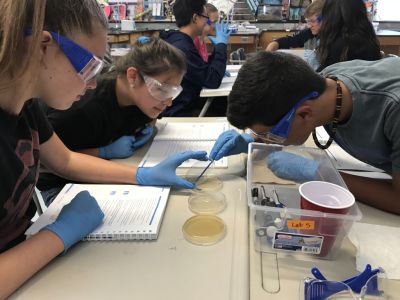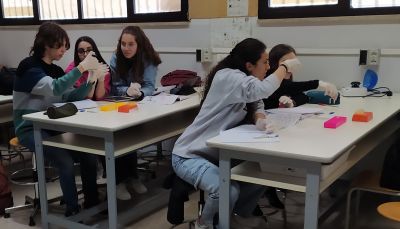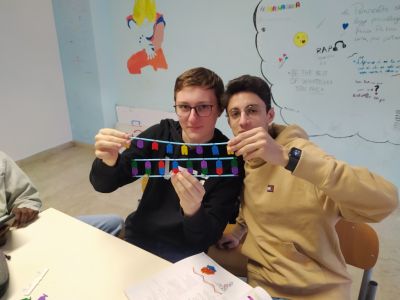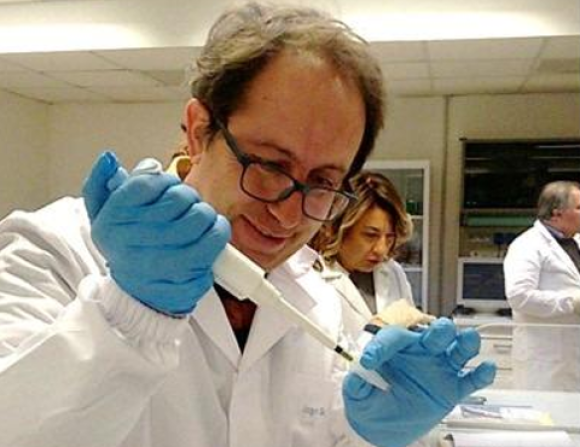With countless hours of work required to teach and assess students as well as to develop and maintain course lessons, teachers often struggle to find time to innovate in the science classroom. That innovation time requires resources and support no matter where they are located—whether at a public school in Los Angeles or a science school in Sicily. For many ABE teachers, they can better reach that elusive goal through the Master Teacher Fellowship.
Not only do ABE Master Teacher Fellows teach the ABE labs in their classrooms, but they also have the opportunity to develop innovative projects all the while connecting with colleagues globally. What results is an amplified ability for these master science teachers to reach their students in new and creative ways.
“Even though my background is in molecular biology, I never imagined that one day I could perform experiments on DNA in a high school,” says Master Teacher Fellow Salvatore Stira. “In the past, the necessary equipment was expensive and bulky and carried safety risks, but now it’s different. It has been very exciting to get to use this equipment in new ways.”
Embracing New Challenges in California
For Joi Hiraishi, the ABE program has affected her day-to-day life in profound ways. Even outside the classroom, going to run errands in her hometown of Camarillo in Southern California, just outside Los Angeles, she is constantly running into former students.
“Many of my past students tell me that they decided to be biology majors because biology was their favorite subject in high school,” she explains. “When they come up to me, they usually explain that the ABE labs were an eye opening experience for them—to do something so high level and be successful at it. They get so much out of the ABE labs; putting the textbook aside, they learn with hands-on real-world laboratory experiences.”

Teaching science at Camarillo High School has been a full-circle experience for Hiraishi. One of ABE’s early adopters, Hiraishi remembers the early days of the program, before it was even called the Amgen Biotech Experience. She came into teaching science more than 20 years ago, after earning a bachelor's of science in biological sciences and working as a postgraduate researcher for the Department of Orthopaedics at the University of California, Davis. She loved the lab work, which involved processing cartilage post-surgery for use in scientific research.
After deciding to move back to Camarillo where she grew up, Hiraishi wanted to teach science at her alma mater, Adolfo Camarillo High School, where she has been working since. Her first several years, she taught an integrated science class but eventually took over honors and other biology courses, including doing the ABE lab series.
Early on, she realized that “the students were enjoying the challenge from the ABE labs,” Hiraishi recalls. “It's all new to them. They've never even seen a micropipette before.”
Being able to have all the equipment in her classroom was huge: “It was just awesome to get the equipment from ABE. I had nothing in my classroom related to biotechnology before that,” she says. Even though doing the ABE labs requires extra work, Hiraishi has enthusiastically continued with it since then, as she continues to see the immense benefits to her students.
From those early years of the program until now, Hiraishi has seen a transformation in the curriculum—evolving from individual hands-on labs to a more robust interconnected lab series. “Lab manuals, extra practice activities, flow diagrams, videos, assessments, and different lab series, to name a few, were added as the years moved on,” she says, making it easier for teachers to stretch the learning out into longer lessons or to select what they have time for.
And now, with her Master Teacher Fellowship, Hiraishi is looking to expand the work she has been doing in biology to her new AP Environmental Science class, devising new lab activities that apply biotechnology concepts to agriculture. “For example, instead of making genetically modified recombinant bacteria using a sea anemone gene that produces red fluorescence protein [from the ABE Foundations of Biotech lab series], they can add a gene that gives the bacteria the ability to metabolize oil or decompose biowaste more efficiently,” she explains.
Hiraishi is looking forward to developing these activities, with the support of ABE, and getting to connect with colleagues globally at an upcoming meeting of Master Teacher Fellows in Boston.
Making Health Connections in Italy
For fellow Salvatore Stira, being able to brainstorm alongside colleagues from around the world has been a highlight of his time as an ABE teacher at Liceo Scientifico Benedetto Croce in Palermo, Sicily. “I like that the ABE Fellowship has two parallel paths: the development of a biology teaching project using provided resources and monthly meetings between master teachers,” he says.
Stira’s 2022 fellowship project looked at a health topic of significance to his local community in Palermo—thalassemia, a form of hereditary anemia widespread in the region. It was important to him to develop a project where “students could fully understand the relationship between basic research and medicine,” he says.
For this project, Stira’s students used molecular biology techniques, such as PCR and electrophoresis, as well as bioinformatic tools and the LabXchange platform, to study and simulate mutation identification techniques. They also investigated evolutionary aspects of the disease, potential gene therapy techniques, and the related ethical and social issues.

Stira was also able to connect his students with the local community, enabling them to perform research experiments at a local research center and to visit a local hospital. “It was important to connect the world of education with that of scientific research through the collaboration of my school with research institutions, universities, and hospitals in the region.”
All these activities have helped Stira’s students develop critical-thinking and problem-solving skills that will be useful to them for the future, not only in science but also in life in general,” he says. “My students are very satisfied with the activities of ABE because they have the opportunity to carry out interesting experiments and to be innovative.”

Stira has received additional support from ABE in the form of a mini-grants that have extended the types of activities he can do with his students. For one of the grants, he acquired kits to do forensic science. “My students were really enthusiastic about this project because they are very interested in forensics through CSI and other TV programs,” he says.
Seeing the transformative changes in molecular biology equipment over the past few decades has been especially meaningful for Stira, who has a PhD in cellular biology. After doing microbiology research after earning his PhD, he decided to become a teacher some 25 years ago, teaching chemistry, biology and geology in a high school. He has been teaching at the scientific school Benedetto Croce in Palermo since 2009 and as an ABE teacher since 2019.
Stira considers teaching experimental aspects of science as core to both the introduction of a new concept and the acquisition of new skills by the students. He also sees science teaching as central to “increasing students’ responsible citizenship by spreading concepts of gender equity, ethics, responsible consumption, care for the environment, sustainability, and health care.”
Both Stira and Hiraishi are grateful for the support they have received through ABE and look forward to continuous innovation in teaching the next generation of global scientists and citizens.
